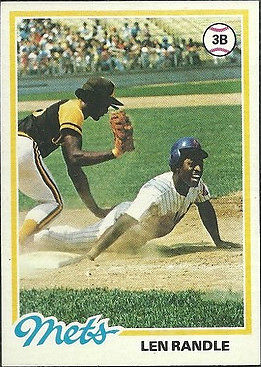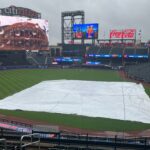
The card above, card number 544 from the 1978 Topps set, is an interesting card of an interesting character during a very non-interesting time period in the history of the New York Mets.
As we often do here in the Shoebox Memories section of MMO, when we see an in-action card, we like to get our Sherlock Holmes hat off the wall and try to deduct some elementary questions such as was who are all the players pictured, or was the player safe or out?
While we go to retrieve our Sherlock Holmes hat off the wall, let’s recall how Lenny Randle, who was a first-round draft choice of the Washington Senators in 1970, came to become such an interesting character, and how he came to be a member of the Mets.
In Spring Training of 1977, Lenny Randle, who was a switch-hitting second baseman with speed for the Texas Rangers (recall that the Washington Senators moved to Texas in 1972) who hat batted .224 in 1976, lost his starting position to Bump Wills. Bump Wills was himself a first-round draft choice in 1975, the son of Maury Wills and had batted .324 in AAA in 1976.
On March 28, the Rangers were in Florida for a spring training game against the Twins. Before the game, walked up to Rangers manager Frank Lucchesi during batting practice and in a premeditated fashion punched Lucchesi, in the face three times. As a result of the attack, Lucchesi was hospitalized for a week, and needed plastic surgery to repair a fractured cheekbone. Lucchesi also received bruises to his kidney and back from kicks delivered by Randle while he on the ground. The Rangers suspended Randle for 30 days without pay and fined him $10,000. On April 26, before the suspension was complete, Texas traded him to the Mets for cash and a player to be named, who eventually turned out to be Rick Auerbach, who never played a day in the majors for the Mets or the Rangers.
With Felix Millan already entrenched at second, Randle was a bench warmer until Joe Torre replaced Joe Frazier as Mets Manager. Torre, was a player-manager for only a few days when he decided to end his playing career and focus on managing. With the opening day third baseman, Roy Staiger, betting only .236 with one home run, and the back up now managing, the path was cleared for Randle to become the Mets regular third baseman.
Now that the history lesson of our program is over, let’s adjust our Sherlock Holmes hat and start to determine when and where the action shown was taken; and once that is established, who the first basemen pictured is; what happened on the play shown on the card, and who won the game:
- Note that the background of the picture shows yellow box seats. I did not remember Shea Stadium having yellow seats in 1977, as we generally sat in the green wooden upper deck seats. However, Randle is wearing what looks to be a home uniform, and this was confirmed by a quick review of historical team uniforms on baseballreference.com.
- In addition, the first baseman is wearing a San Diego Padres uniform, and this was confirmed to be their road uniform at this site.
- So we now know that this game was played at Shea Stadium.
- As 1977 was Lenny Randle’s first season playing for the Mets, we know it is from the 1977 season, and not a prior year during his career.
- Referencing the Mets schedule from 1977, we find that the Mets played had three home games against the Padres on May 11, and 12, and three more on July 29 – 31.
- Looking at the card again, we see that the game is clearly a day game, so the three games in May, which were night games, and the first Friday night game against the Padres on July 29 can be eliminated as possibilities.
- Before we look at the box scores and play by play for each of those two games, note that the Padres’ first baseman is African American. The box score for the July 30 game shows that while Randle did have a hit, it was a triple. Moreover, the Padres’ first basemen that day were Dave Kingman and Mike Ivie, both Caucasian ballplayers. With the July 30 game eliminated, let’s turn to the July 31 game.
- In the July 31 game, Randle singled to center in the third inning, but with Felix Millan at-bat, was picked off first. However, the pickoff throw was wild, and the pitcher was charged on an error as Randle went to third. The card shows the beginning of this play as Randle is about to bound to his feet to scamper around the bases. The San Diego first baseman that day was Gene Richards, an African American rookie that season. Randle later scored an unearned run that inning on a single by Steve Henderson. Other at-bats by Randle that day would not result in a pickoff at first. The Mets were victors that day, winning the game 10 – 9.
Randle had a very good 1977 season for the Mets, hitting .304 and stealing 33 bases. As noted on the back of the card, Randle ended a 15 inning game with a homer. Less than two weeks prior to the game shown on this card was played, Randle was the Met at-bat when the lights went out due to New York’s 1977 blackout. Having hit the ball, Randle just kept running until the umpires ruled the game suspended.
My favorite Lenny Randle memory was on Sports Center for years. Playing third for the Mariners, he tried to blow a bunted ball that was near the line foul. No baseball card of that play was made, however, unlike the play we have recorded on our baseball card
Conclusion: We now know the game, players, score, and outcome pictured on the card.
Let’s declare this case closed, and put our Sherlock Holmes hat back on the wall.
Do you have a favorite in-action card you would like us to research here at MMO? If so, please put the card in the comments below.















